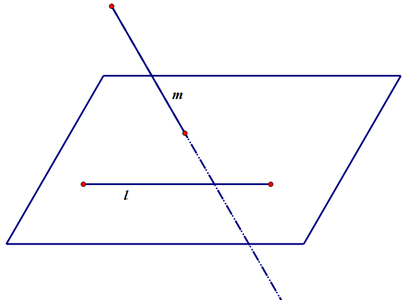정의[편집 | 원본 편집]
삼차원 이상의 공간에서, 만나지도, 평행하지도, 일치하지도 않은 관계. 위 그림에서는 직선 [math]\displaystyle{ l }[/math]과 직선 [math]\displaystyle{ m }[/math]이 꼬인 위치에 존재한다. 어떤 두 직선이 꼬인 위치에 있기 위한 필요충분조건은 "두 직선이 같은 평면 위에 있지 않다"이다.
사이각[편집 | 원본 편집]
꼬인 위치에 존재하여도 두 직선 사이의 각도를 정의할 수 있는데, 벡터의 내적을 활용한다. 예를 들어 직선 [math]\displaystyle{ l }[/math]의 방향 벡터가 [math]\displaystyle{ \vec{v_1}=\left(a,b,c\right) }[/math], 직선 [math]\displaystyle{ m }[/math]의 방향 벡터가 [math]\displaystyle{ \vec{v_2}=\left(x,y,z\right) }[/math]라 한 뒤, 내적 [math]\displaystyle{ \vec{v_1}\circ\vec{v_2} }[/math]을 사용해 사이각을 구하면,
- [math]\displaystyle{ \begin{align*} \left\|\vec{v_1}\right\|\cdot\left\|\vec{v_2}\right\|\cdot\cos\theta &= ax+by+cz \\ \cos\theta &= \frac{ax+by+cz}{\sqrt{\left(a^2+b^2+c^2\right)\left(x^2+y^2+z^2\right)}}\end{align*} }[/math]
이고, 역삼각함수를 이용해 [math]\displaystyle{ \theta }[/math]를 구하면 된다.
거리[편집 | 원본 편집]
꼬인 위치에 있는 두 직선 사이의 거리는 벡터의 외적을 이용한다. 두 직선에 수직인 단위 벡터는 [math]\displaystyle{ \vec{n}=\frac{\vec{v_1}\times\vec{v_2}}{\left\|\vec{v_1}\times\vec{v_2}\right\|} }[/math]이고, 각 직선 위에 존재하는 임의의 점을 벡터를 각각 [math]\displaystyle{ \vec{u_1},\,\vec{u_2} }[/math]라 하자. 그럼 두 직선 사이의 거리는 [math]\displaystyle{ \vec{u_2}-\vec{u_1} }[/math]를 [math]\displaystyle{ \vec{n} }[/math] 위로 사영시킨 벡터의 크기와 같다. 따라서
- [math]\displaystyle{ \text{proj}_{\vec{n}}\left(\vec{u_2}-\vec{u_1}\right)=\frac{\vec{n}\cdot\left(\vec{u_2}-\vec{u_1}\right)}{\left\|\vec{n}\right\|^2}\vec{n}=\left(\vec{n}\cdot\left(\vec{u_2}-\vec{u_1}\right)\right)\vec{n} }[/math]이고, 따라서 [math]\displaystyle{ d=\left|\text{proj}_{\vec{n}}\left(\vec{u_2}-\vec{u_1}\right)\right|=\left|\vec{n}\cdot\left(\vec{u_2}-\vec{u_1}\right)\right| }[/math]이다.
